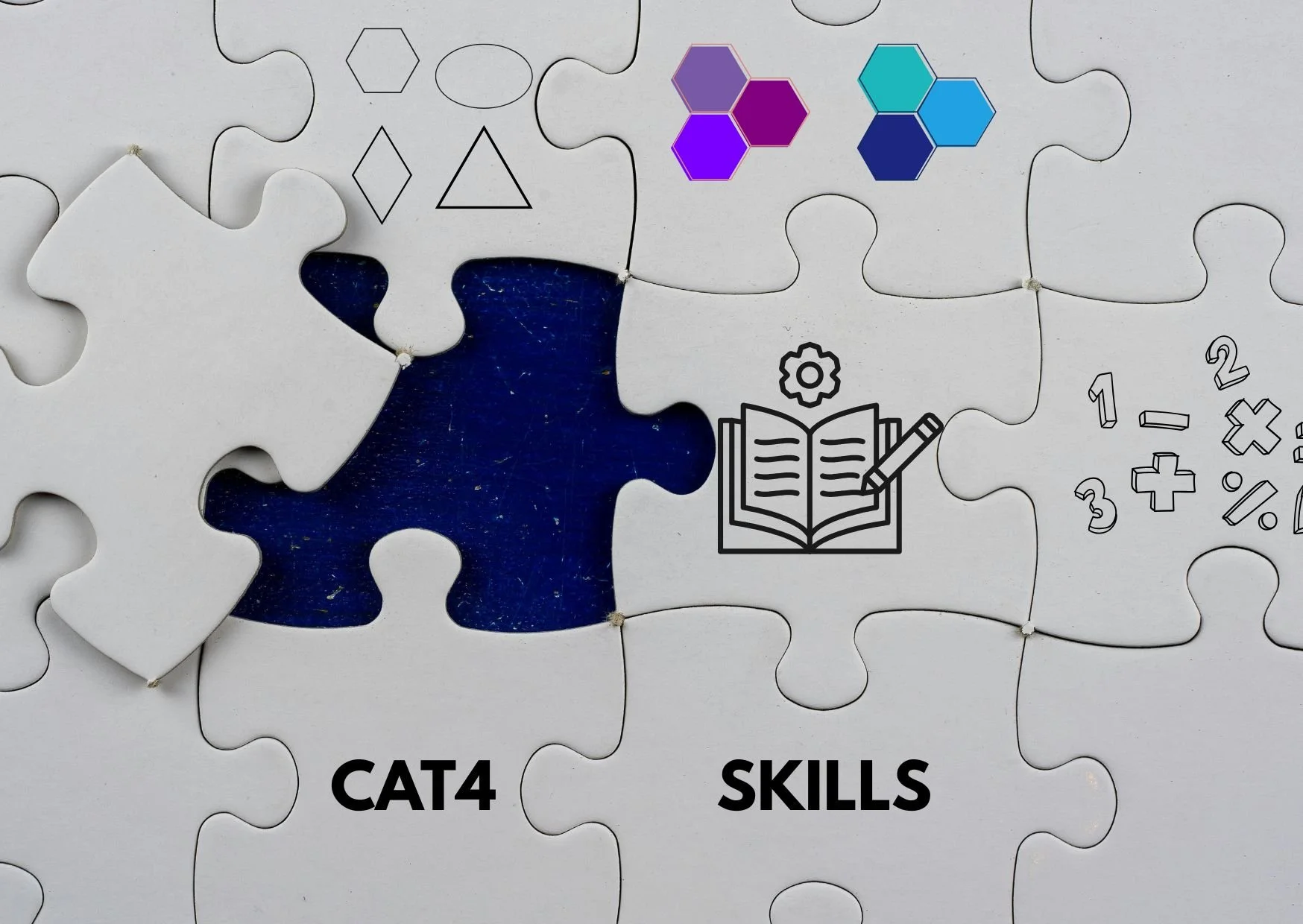Excel at the CAT4: How Tutoring Unlocks Your Child’s Potential
What is the CAT4 Test?
The CAT4 (Cognitive Abilities Test, 4th Edition) is a powerful tool developed by GL Assessment, designed to understand a student's potential rather than their memory. The CAT4 isn't about academic achievements, facts, or textbooks; it evaluates reasoning abilities to measure students' thinking across four core areas called batteries. These batteries are:
Verbal reasoning: understanding and reasoning using language and words.
Quantitative reasoning: using logic and patterns to solve numerical problems.
Non-verbal reasoning: solving problems with shapes and visual patterns.
Spatial reasoning: Visualising objects in space and predicting transformations.
Crucially, there is no straightforward pass mark for the CAT4. Instead, results offer teachers valuable insight into students' cognitive strengths and challenges, revealing the kind of learners students are and their natural potential.
The test is non-adaptive, meaning the difficulty level stays constant rather than adjusted based on a student's responses. The CAT4 is used across schooling, though each age group has a different test. It also uses standardisation to compare students to the national benchmarks for their age.
It varies by school, but the test may be online or on paper. Timings and formats vary by year group, but Levels A-G (Years 3-11) typically have 72 minutes of actual testing. The test consists of three parts, with an introduction before each session, which includes practice questions. Factoring in this and breaks between parts, the process tends to be around 2 hours and 15 minutes. The order is non-verbal reasoning in part 1, verbal reasoning and numerical reasoning in part 2, and the remainder of the numerical reasoning and spatial recognition in part 3.
See the GL Assessment Website for further information for parents about the CAT4.
Who Uses the CAT4 Test and Why?
Various schools worldwide use the CAT4, including UK grammar schools, International Schools, British curriculum schools abroad, and independent and state schools for internal assessments.
A key use of the CAT4 is part of the school entry selection criteria. It often forms the basis of the 11+ exam, determining who will gain year 7 entry to a school. One example of this use is the Kent Test, the CAT4 test, which is administered to children looking to gain admission into any grammar school in Kent, such as Cranbrook School.
Another common use is when schools use it to inform teachers at different points during schooling, such as early in year 7. The test can help organise students into streams or sets, identify individual learning needs, and track student development. It's even able to predict potential academic performance.
Highly regarded for its data, the CAT4 reveals a wealth of information about students' thinking abilities, going far deeper than traditional right or wrong answer tests.
What Skills Does the CAT4 Test?
All CAT4 questions are multiple-choice (usually offering five options to choose between), and each section taps into different styles of thinking, with two question styles per battery.
Verbal Reasoning
Verbal reasoning tests students’ ability to identify how language is used, specifically by establishing patterns and relationships between words and ideas. Understanding word knowledge, word relationships, and language development at a level appropriate for their age should be sufficient to answer the questions, rather than memorising vocabulary. The following questions assess how a child reasons using language:
Verbal Classification: Identify the conceptual link among the three given words and choose one other that best fits the group.
Verbal Analogies: Questions follow an A-B: C-? format. Establishing the relationship between A-B gives the student the answer as to which option pairs with C. For instance: boat-sea as car-road.
Quantitative Reasoning
The quantitative reasoning section assesses mathematical problem-solving abilities by examining students’ understanding of numbers, patterns, and relationships. Though the test doesn’t examine knowledge of mathematical facts, a solid foundation in arithmetic is key to success:
Number Analogies: Find the rule connecting three number pairs and complete the fourth.
Number Series: Predict the following number in a sequence using logical patterns.
Non-Verbal Reasoning
Using shapes, designs, and patterns, this section of the assessment tests how well students process visual information. Students must identify similarities, differences, and relationships between the diagrams to solve problems. Elements don’t strictly relate to school learning, as they don’t use words and numbers. The pictures, or figures, test visual thinking and logic via:
Figure Classification: Spot the rule among the three figures and pick the next one in the set.
Figure Matrices: Complete visual analogies by identifying relationships between images. Again, it is A-B: C-? format.
Spatial Reasoning
Spatial reasoning is about 3D thinking, visual memory, and mental rotation. It requires students to create and manipulate a complex image in the mind and tests this ability through the following:
Figure Analysis: Predict what a repeatedly folded and hole-punched square of paper will look like when unfolded.
Figure Recognition: Match a simple outline to its presence in a more complex design.
Why Take a CAT4 Practice Test?
While the CAT4 doesn’t test taught knowledge, doing a CAT4 practice test can still provide significant benefits:
Reduces anxiety by familiarising your child with question styles.
Improves time management and focus.
Identifies target areas for improvement.
Builds confidence through exposure to new reasoning formats.
The GL Assessment Website offers a few official examples, but they’re limited, and there is no complete practice test:
‘What is in each battery?’ Webpage
The Teacher Guide (n.b., this can be hard to follow)
Other familiarisation material:
Use third party material cautiously, as much of it does not accurately reproduce test content.
Be wary of any material that isn't directly from GL Assessments.
Exceptions include resources in partnership with GL Assessments, such as the Kent Test Familiarisation Guide. However, it may still differ from the test your child will sit, especially if they aren't sitting the Kent Test.
The lack of reliable online test material is where expert support and structured mock testing from U2 Tuition can make all the difference. Our tutors possess specialist resources, including mock papers and familiarisation materials, which they employ in their sessions to help students succeed.
How U2 Tuition Helps With CAT4 Success
At U2 Tuition, we specialise in CAT4 tutoring tailored to your child's needs. Our expert tutors don't just teach the test; we guide students in building the cognitive skills behind it.
While the CAT4 test assesses natural thinking ability, how students are introduced to the test can make a huge difference. Exposure, confidence, and strategy are key to performing well, especially under pressure.
A CAT4 tutor from U2 Tuition can mean the difference between an average score and one that enables entry to schools and advanced academic pathways.
With U2 Tuition, your child will:
Access specialist familiarisation resources developed by tutors.
Complete targeted CAT4 mock tests with feedback.
Build key verbal, quantitative, spatial, and non-verbal reasoning skills.
Receive personalised support based on their test performance.
Strengthen core English and maths skills that support reasoning.
Learn strategies for tackling unfamiliar problems.
Get guidance on the next steps, including school options and subject strengths. For example, a high spatial score indicates STEM-related strengths.
We offer online, hybrid, and in-person London tutoring. Please enquire about in-person tutoring in other areas of the UK.
We also assist you as parents, helping you understand your child's results and appreciate their individuality, enabling you to best support them in their next steps.
Beyond CAT4, we offer support for school interviews, 11+ preparation, and subject-specific tuition in English, Maths, and Sciences. Our goal is to support your child for the exam and the long term.
At U2 Tuition, we believe every child deserves the opportunity to succeed. Whether they're sitting the CAT4 in the UK or abroad, we'll support them every step of the way.
Book a free 20-minute consultation to learn more about how we can help.





